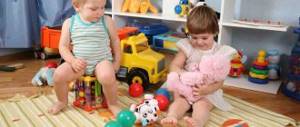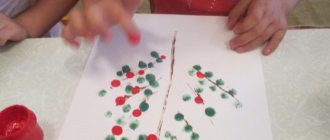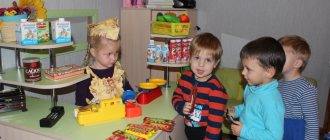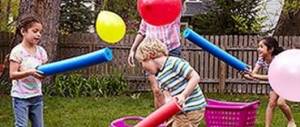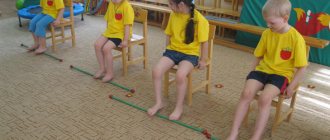Play activity
When mastering objects, play actions , “make-believe” actions based on imitation of the actions of adults. The child feeds, rocks, puts the doll to sleep, can drink from an empty cup, etc. The main difference between children's games at this age is the impossibility of introducing elements of imagination into the game. At the age of 15 to 18 months, children are able to act “pretend” only with objects similar to real ones (they can feed adults or dolls using real or toy cups and spoons). Then they can already use one object as a substitute for another, they can imagine that the object can represent something other than it actually is (a cube is a cup, a broom is a horse). Games at this age are characterized by episodic, primitive plots and monotony of actions performed. The main content of the games is the reproduction of observed objective actions (“cook porridge”, “feed a doll”, “talk on the phone”). At the end of the second - beginning of the third year of life, the phenomenon of “role in action” can be observed in the child’s behavior. A child often plays out the life of adults: he dresses up like his mother, talks on the phone like his dad, digs in the garden like his grandmother. In his game, he personifies everything that he sees in his environment. A child, reproducing the actions of a specific adult from his environment, is not aware of this, but willingly agrees when he is told this (“You speak on the phone like dad. Masha (child’s name) is dad”). Later, he himself notices the similarity of his actions with the actions of an adult and calls himself by his name or role in the family.
The listed stages of development of object-based play simultaneously constitute the prerequisites for plot-role-playing play. The child needs help, keen interest, and practical advice from adults. An adult, with his suggestions, gradually complicates and adds variety to the game; provides the material side of the game: selects toys, materials (dishes, clothes, tools, etc.).
Another type of objective actions is correlating actions - bringing several objects into a certain spatial relationship: folding a nesting doll, a pyramid, a construction set, inserting figures of different sizes and shapes into holes. As a rule, “educational toys” are aimed at precisely this type of play action.
Separately, it is worth highlighting actions with simple toys . No specific and unambiguous actions are required with them; on the contrary, actions with toys presuppose the child’s complete freedom. Actions with simple toys do not have a specific purpose; they are carried out “just like that.”
All types of games have their own characteristics and purpose, but there are no clearly defined boundaries between them, and in each situation they can overlap each other.
In addition to playing with objects and toys, there are also:
Motor games - walking, running, jumping, spinning and other actions related to movement. The child gets pleasure from the process itself. This is one of the first games that babies indulge in, blowing bubbles from saliva or simply swinging from side to side. Children, with the participation of adults, can perform the same movements for a long time, which not only gives them an emotional charge, but is also a good exercise for developing coordination of movements. Motor play is often initiated by adults and is one of the first opportunities for communication in infancy and early childhood.
Sensory games . The goal of this type of play is to gain sensory experience for its own sake. Children can endlessly splash water, chew blades of grass, rattle dishes and tear petals from flowers just to enjoy new sounds, smells, tastes and tactile sensations. Through sensory play, children learn about their physical and sensory capabilities, as well as the properties of the things that surround them.
Overall, play helps a child to satiate their curiosity, explore the world around them, and experiment in a safe situation. Play is also called “children’s work” due to the importance it has in the development of a small child. It helps improve sensory and cognitive abilities, physical skills, creating every opportunity for the child to hone and expand newly acquired skills. In other words, the game is truly a work aimed at development.
